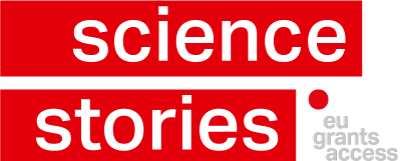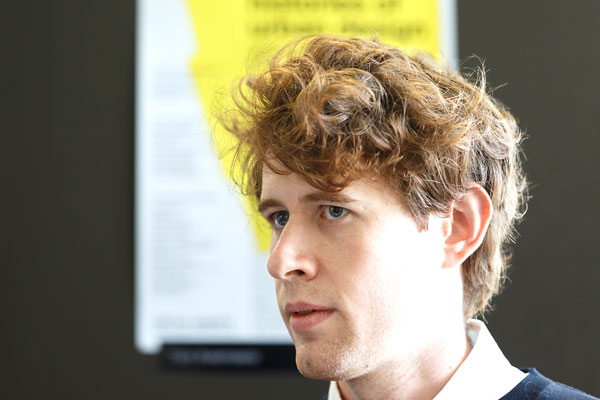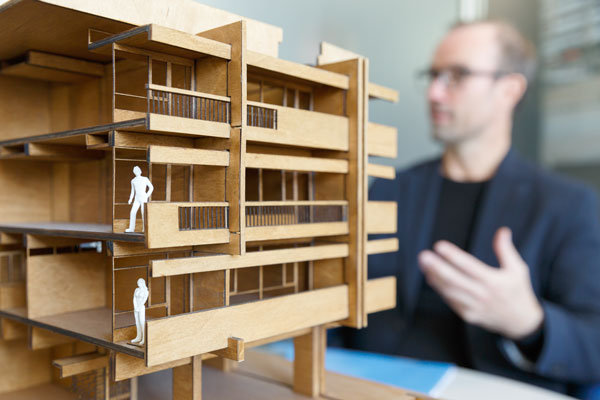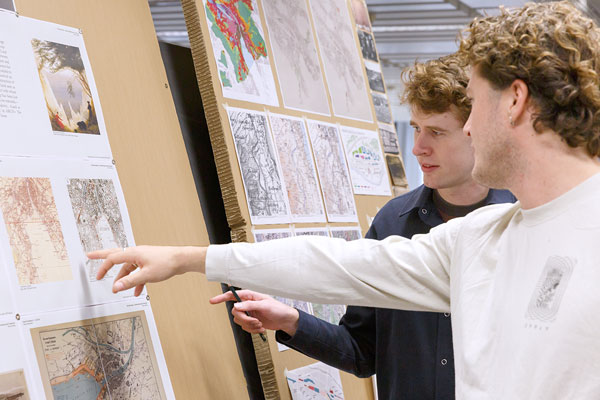
The power of silent architectural design knowledge
Tacit knowledge has long played an important role in architectural education and practice. Tom Avermaete, Professor of History and Theory of Urban Design at ETH Zurich, is coordinating an EU research project on this called TACK / Communities of Tacit Knowledge: Architecture and its Ways of Knowing. A conversation with him and PhD student Hamish Lonergan about the transfer of knowledge without words.
Tom Avermaete, you are coordinating an «Innovative Training Network», an ITN of the Marie Skłodowska-Curie Actions of Horizon 2020 about tacit knowledge. What is this?
Tom Avermaete: The notion of tacit knowledge is a very difficult notion to understand. The best way to explain it is to think about what architects and urban designers do in the city: they have a capacity to bring things together that you normally would not bring together.
Can you give me an example?
A good example in Zurich is the building complex Kalkbreite. On paper, it is a transport infrastructure, a tram depot, which normally you want to have far away from the city in terms of noise and size. But in Kalkbreite, this infrastructure is innovatively connected to living, shopping and cultural spaces. That is what tacit knowledge is about: the innovative capacity to combine, through design, different things that you normally would keep separate. We call this knowledge ‘tacit’, or silent, because you can’t write a recipe for it. This type of knowledge needs to be passed on in projects – by looking at examples of your professor, by designing something together. We are very happy to have this research project, because in the field of architecture and urban design, tacit knowledge is a very central issue.
The term tacit knowledge was introduced by Michael Polanyi in the 1950s, a chemist and philosopher. Since when has it played a role in architecture?
Hamish Lonergan: There have been a few moments when architects became very interested in the idea of tacit knowledge. One moment was in the 1970s and again much more recently in the last decade. Our project is part of this second wave of interest. In the seventies you had educators in Canada, in the United States, in parts of Europe, who had a great interest in tacit knowledge which also affected the ways in which they taught. What we are trying to do is something more comprehensive by not only looking at architectural education, but also at how tacit knowledge operates in practice.
How long have you been involved with this subject?
Avermaete: Quite a few years. I started when I was still working at the Delft University of Technology with smaller projects and I found colleagues internationally who were interested in this subject as well. And building from there a bigger research community, we have all gathered now in this ITN project. Step by step, it took us five years from the small projects to the bigger one.
Was it your idea to apply for a Marie Skłodowska-Curie Actions Grant?
Yes, together with my colleagues, who supported me very much. There seems to be internationally a new interest: We want to better understand the capacity of architects, and of architectural design knowledge, to deal with complex societal problems. So, this was a fantastic opportunity to connect important research centres like KTH in Stockholm in the north of Europe to the Polimi in Milan in the south. We were all convinced that tacit knowledge is an important issue. But until now, nobody had dealt with it in the field of architecture in a fundamental way. Here and there, there were smaller projects dealing with it, but not on the scale of ten doctoral research projects as we do it now.
How important is tacit knowledge in teaching and practice?
It’s very important in the daily practice of architects when you work in a team. Tacit knowledge passes on from one team member to the other. And it is super important in education: in architecture, we have a particular form of education, the so-called studio education, where you closely work together with your professor and assistants, and gradually learn their tacit knowledge.
Lonergan: There is recognition even outside of architecture that the studio model is successful in passing on exactly this tacit knowledge, the kind of intangible knowledge of how to do something. But I don’t think we have been very good at expressing what exactly is successful about this model. This is one focus of our project, particularly the way that the studio works as a community. It is not just a one-directional transfer of knowledge from the professor to the student or an assistant to the student. A studio works as a collective and tacit knowledge is generated in that community.
What exactly do you learn then in these studios?
We learn how design can offer innovative and unexpected solutions to complex problems. This learning is very much a collective venture, where you draw on your peers as well as on professors. It’s really this unit of the studio as a whole that helps to transfer or develop tacit knowledge.
Do all universities in Europe work with this kind of teaching?
Avermaete: Many universities work with studio teaching, but not many are doing it in a methodological way. We are trying to understand what this kind of teaching can contribute, because architects are dealing with very complex problems. We need to combine economical parameters with social, material and ecological parameters – all in a single project. You can’t do this as a single person. So, you need to do it in a team and thus sharing knowledge among people without writing it down and while working. This is very important in order to deal with the problems that our cities and territories encounter today.
We call this knowledge ‘tacit’,
or silent, because you can’t write
a recipe for it.
The parameters are getting more and more.
Right. We are facing enormous challenges in terms of climate and energy in our cities. This requires tacit exchange of knowledge in a project team. This is what we are teaching our students. And in our project, we want to understand better how we can activate and operate that co-production of knowledge.
Lonergan: … and also how to communicate between people inside the community and those outside. I think that one of the big challenges of tacit knowledge is that it is relatively easy to understand inside the community. But, for instance, when a group of architects has to communicate a design to members of the public or a group of engineers, the knowledge gap between these communities is often a big challenge – particularly when you get these much more complex problems like a whole city or climate change. One of the insights that we had is that the way to bridge between the tacit knowledge of one group to another’s is to focus on tangible things, on materials, on a drawing or a model or the building itself – what in this project we call material “vectors”.
So, you want to give tacit knowledge the importance it deserves?
Avermaete: Yes. There are so many problems that are dealt with in a completely quantitative way. We can’t solve the large societal and ecological issues that we are facing today with simple excel sheets, where we see how much concrete we use, how many square metres we have. We need more complex attitudes to deal with the “wicked problems” of our era: this requires sharing knowledge in a team, looking at particular situations and activating tacit design knowledge to address this particular situation and to find innovative solutions.
Hamish, you study a historic aspect of tacit knowledge. Can you tell me more about it?
Lonergan: My project has two parts, one part which is historic and one more contemporary, but both looking at design studio education in universities. So, I am interested in these two moments mentioned before, when tacit knowledge was of interest to architects. One key case study in the 1970s is the International Laboratory for Architecture and Urban Design, or ILAUD. That was a summer workshop in Northern Italy where a lot of different schools came together to deal with complex architectural problems, each school with its own tacit knowledge, some from a more technical background, others from more humanistic or artistic backgrounds. What I am really interested in is the way people from different communities come together around architecture to negotiate differences in their tacit knowledge and discuss these kinds of complex problems.
We can’t solve the large societal
and ecological issues that we are
facing today with simple excel sheets,
where we see how much concrete
we use, how many square metres
we have.
And what about your contemporary study?
In this one, I am interested in ETH Zurich and the way the final “crit” or reviews function in design studios, where the students present their work to guest critics and professors, but also to engineers and other students. And again, I am interested in the different ways that people from these various communities discuss architecture, but also the strategies that they use to bridge between their differences of tacit knowledge. I come back to these vectors, where perhaps an engineer points at a model and asks a student — “what’s happening there?” — and the student is able then to point to the same model and explain how their project deals with the various complex issues. I am interested in these moments of encounter of different communities.
Avermaete: This contemporary part of the study is using ETH Zurich as a sort of laboratory, observing what is already happening in architectural education and trying to conceptualize it.
This project ends in November 2023. What is still to come?
Avermaete: We are already close to the end. In June 2023, we will have a big final conference at ETH Zurich, but also a final exhibition and a final online publication. So, the biggest outcome of this project will definitely be the ten doctoral works, but also this online publication, which will remain online and will hopefully function as a sort of knowledge base for people in the future when they will try to do more research on tacit knowledge in architecture.
Lonergan: It will include things like online teaching modules, where future educators might teach the idea of tacit knowledge from the ten different perspectives of the project.
Will you continue the collaboration with your partners?
Lonergan: Absolutely. A part of the project has been meeting every four months to collectively discuss our research and present our ideas back to each other and use that as a way to develop each of our research projects. And also amongst supervisors, practice partners and institutional partners. So even though the project itself stops, these conversations will continue in more or less formal ways.
Do you have any plans for other EU projects?
Avermaete: At the moment we are thinking about what could be the next step. We still see a lot of possibilities in this field. The network is very strong. And for me, the commitment that it takes to coordinate such a program is rewarding as it has as an important impact on my field.
Interview with Tom Avermaete
Tom Avermaete
Tom Avermaete is since 2018 Professor for History and Theory of Urban Design at the Institute of History and Theory of Architecture (gta) of ETH Zurich and since July 2021 head of the gta Institute. Born in 1971 in Antwerp, he studied architecture in Belgium and Denmark and obtained an MSc degree and a PhD in the history and theory of architecture at the University of Leuven, Belgium. Avermaete was lecturer at the University of Copenhagen (1997), leader of the Centre for Flemish Architectural Archives at the Flemish Architecture Institute (2003), as well as associate professor (2006) and full professor of architecture (2012) at Delft University of Technology, The Netherlands. He is on the editorial board of the “OASE Journal for Architecture”, member of the advisory board of the “Architectural Theory Review” and “Docomomo Journal” and a co-editor of the series “Bloomsbury Studies in Modern Architecture”.
Hamish Lonergan
Hamish Lonergan is an architect and doctoral student in the gta Institute at ETH Zurich. His research has appeared in conferences and publications including “Footprint”, “gta papers” and “OASE Journal for Architecture”. He graduated with a Master of Architecture from the University of Queensland, Australia, in 2017. Before joining the gta in 2021, he worked at COX Architecture (2018-2020) and curated the exhibition Bathroom Gossip (Brisbane, 2019).
Horizon 2020 Project
TACK: Communities of Tacit Knowledge: Architecture and its Ways of Knowing
- Programme: Marie Skodovska-Curie European Training Networks
- Duration: 1. September 2019 – 31. August 2023 (48 months)
- Contribution for ETH Zurich: 557’637 €





